American Sabbatical 85: 4/4/97
Fairhope
4/4.. Fairhope, Alabama.
Destiny had washed us ashore in Destin, Florida, last night. This morning the wind was still
pushing humid gusts into Choctawatchee Bay. I strolled around
the west end of the sandspit, among rude bar parking lots (“Hosers”,
with an antique fire engine out front), grubby picnic areas, half-constructed
spas, and cheap motels. Even in the raw breeze I was comfortable
in my Salvador Dali Lobster-telephone T-shirt. (What kind of luck
is that going to bring me?) I’m not sure this is a destination
resort, though. When I went to get Peggy’s morning java in the
motel lobby, the framed photos there were satellite images of
hurricanes centered on this strip of coast. Nostalgic seascapes,
I guess.
| I’ve noticed that destination motels run on different schedules
than the drive-through kind. Down in Lauderdale there wasn’t a
soul stirring before 9 AM, while out on the highroad the doorslams
and engine revs start at daybreak. Here in Destin wheels were
spinning early. We kept moving, too. |
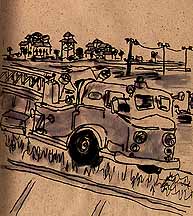
Hosers
|
We had a double-barreled target. Peggy’s mother had been sent
off to a progressive high school in Fairhope, Alabama, in the
1920s, and Peggy wanted to track down this episode of family history.
Then, as we were plotting our course from Maine, we got an e-gram
suggesting we seek out the artwork and company of Joe Miller,
an artist in Fairhope, and friend of one of our e-companions.
So Fairhope it was.
First we had to do a touch-and-go at Pensacola and enjoy the familiar
Naval Station ambiance. Scrubbed transience with chain-link. At
least the big pines looked healthier than in the blasted landscape
at Camp LeJeune. Then dodging through backstreets of Pensacola
proper and making all haste for the Alabama line. Will we get
out of FLA without getting squeezed and concentrated?
Yes, M’am. Into Alabam. “The Heart of Dixie” the plates say. Sometimes
crossing a state line seems like an exercise in political absurdity,
while other times there’s a distinct transformation in landscape.
After the “unique awfulness” of Florida, Alabama seemed verdant
and welcoming. Green meadows of knee-high grasses. Fields of ripe
strawberries and vine-red tomatoes. Best of all, acres of noble
vase-shaped pecan trees, just beginning to leaf out, with herds
of cattle chomping the under-forage. Egrets following the kine.
You could believe yourself to be back on the fringes of the great
eastern woodlands which stretch almost all the way home.
Florida is a place without time. A permanent vacationland, without
seasons or restraint. In the Sunshine State we rarely encountered
that charge of historical current we’ve stuck our fingers in all
over America. Alabama felt like a place long lived in and full
of old tales, at least between Lilian and Fairhope.
I’d lain in bed last night trying to remember which old journal
I’d read that had recounted voyages, and strandings, along this
bit of coast. Ducking in and out of the lagoons between here and
New Orleans and back, then setting off upcountry into Indian country
in the late 1700s. Was it Bartram, again? Must be. This morning
we started seeing signs for the William Bartram Historic Trail.
Back on the old roads.
Fairhope sits on the east shore of Mobile Bay, and we came into
town on the coast road from the south, where new money and old
has piled up some elegant manses. We figured more exclusive access
and peons take the hindmost, but quickly got slapped on our class
consciousness. Public parks shaded by proud oaks line the beachside
as you come into town. Town itself looks like a destination shopping
resort, with lots of galleries, boutiques, and a serious case
of the quaints. With pearls and BMWs.
A couple of false turns led us to the Library, and while Peggy
researched the Organic School, I nosed about asking after Joe
Miller. “Gone to Mexico.” “No, I saw him walking in town the other
day.” Finally someone shows me how to use the local phone book,
and I find his address on School Street. Turns out the Organic
School is still going strong, although moved to new digs, and
that school on School Street was the old campus. Looks like serendipity
is doing it again.
Cruising in search of a fabled sculptor we encounter a yard that
says, “This is it!” Thank god for artists. They can turn an ordinary
side street into an inspirational journey. And when we knock on
the door Pat, Joe’s wife, welcomes us in like old friends. We
didn’t know how hungry we’d been for some friendly face-to-face.
Joe drove up in his road wagon shortly after, and we were swept
up in family hospitality. Their son Kevin was ashore from his
drill-rig service boat, and their grandson made us all smile with
his 5-year-old delight.
Joe walks us over to the old Organic School campus. He actually
taught art there one year, and his kids got part of their schooling
there. A small museum in the main building has memorabilia of
the Organic’s early days. Including pictures of Peggy’s mother,
and both of Peggy’s aunts. She’s in rapture. History to the bone.
(Memo #77)
April 4 Fairhope Organic School
Who? my mother and aunt
What? The Organic School
Where? Fairhope, Alabama
When? 1920’s to today
How? Marietta Johnson established progressive school
Topics: progressive education, organic education, child development,
John Dewey
Questions: What IS an organic school? Why was it started in Fairhope
Alabama? Why did my mother and aunts - raised near Philadelphia
- attend a far out school in Alabama? |
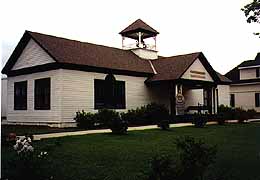
Old Organic School
|
Fairhope, Alabama, was a personal history destination. My family
told me that my mother and aunt (Priscilla and Elizabeth Mead)
went to a “way out” school in Fairhope Alabama, in the 1920’s.
That’s why, I was told, my Aunt Liza was so artistic (also why
she couldn’t spell !). Apparently my mother stated that she wanted
to “go to a real school” after being there a while, but Aunt Liza
adored it and became an artist and art teacher. No relative knew
any more.
Before we set out on this trip, I wrote to the Fairhope Chamber
of Commerce asking about such a school. I received a cordial reply
identifying the school as “The Organic School”. That sounded right.
I also learned that Fairhope was an art colony on the east side
of Mobile Bay. So Fairhope went on the list of “must-sees” for
our southern trip.
Today Fairhope is an affluent and picturesque village within commuting
distance of Mobile across the bay. There are lovely grassy park
areas along the water, a yacht club, a few spanking new condominium
rows, and a main street lined with art galleries, antique shops,
and boutiques. The huge trees and lush plantings make it a green
and shady place. The locals complain bitterly that Money magazine
has recently identified Fairhope as the nicest retirement community
in America which will create a continuing population explosion.
It started as an idealistic community of single tax supporters
who still control a lot of land through their corporation.
I began my search in the Fairhope town library where I found a
book by the school’s founder Marietta Johnson (Thirty Years with
an Idea -The Story of Organic Education) AND discovered the school
was still alive !! We asked directions, and drove out of town
a ways to the school. The small modern brick buildings were all
closed up (school vacation) but the custodian was there. His son
goes to the school which is now Kindergarten to eighth grade.
He said the original campus was sold some years ago, but was still
right in the middle of town. Back we went to Faulkner State University
which inhabits the original Organic School buildings (white frame
cottages with dark green trim) and there was the Marietta Johnson
Museum! It’s in one of the original classrooms, which was stuffed
full of photos, memorabilia (from an OHS cheerleader sweater to
a piano used for the important music activities) AND YEARBOOKS.
The staffer on duty (a graduate of the school) poured over the
file cabinet and yearbooks with me. BINGO. There were pictures
of Liza and Priscilla with their classes in two of the mid 1920’s
yearbooks.
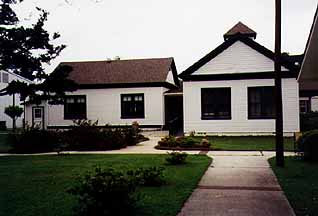
|
Organic education shows the influence of early twentieth century
theories of psychology as much as surrealist art do. Marietta
Johnson began teaching in a traditional school (which she later
called a “factory school”), but was totally transformed by several
books describing child development. She created organic education
from the belief that “natural laws of human growth must be respected
and used if children are to be well developed and well rounded.”
The school received a ten acre site from Fairhope’s Single Tax
Foundation in 1909 and was at its zenith in 1913. |
“Education, to be of greatest value - to result in the best balanced
adult - must be geared to the physical, mental, spiritual development
of the child.” She believed that the needs of the growing organism
include: (1) music and rhythm, dancing, singing; (2) fullest self-expression
through an abundance of handwork; (3) nature study, which may
be called science in later years; (4) stories of history and geography
that later become the social studies, literature, and languages;
(5) fundamental conceptions of numbers which naturally grow into
all mathematical work. The key was self-prompted activity. There
was/is a curriculum geared to individual development, students
were/are grouped by age, but no grades, no report cards, no examinations.
Photographs show students folk dancing, doing a variety of crafts,
participating in classes (often out of doors). High school students
took two years of Latin or French, four years of science (biology,
botany, physics, chemistry), four years of history, two years
of arts and crafts.
Marietta Johnson said that teachers have to love/understand/be
interested in children, have a solid basis of scholarship, and
be concerned about social welfare issues.
| The Organic School was considered quite radical and progressive
and was known throughout the United States and Europe. Ms. Johnson
traveled a great deal lecturing about organic education and helped
found the Progressive Education Association. Other schools were
formed in the same era using similar ideas (from the Edgewood
School in Greenwich to my own high school, Dalton, which is mentioned
in Mrs. Johnson’s book). John Dewey visited Fairhope and described
the Organic School in his book Schools of Tomorrow. |
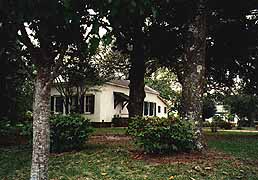
On campus
|
I felt elated to know so much about the mystery school, but better
was to come. We contacted friends of friends who live in town.
The Millers took us in, gave us a wonderful dinner and a walk
by the Bay, and connected me with Dorothy (Dot) Cain who has been
with the Organic School (as student, then teacher, now historian)
all her life. She has established the Marietta Johnson Museum,
organized the archives, taped former staff and students, and successfully
lobbied for the republication of Ms. Johnson’s books. “Momma Dot”
is an important figure in Fairhope.
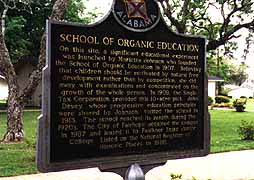
Historic Marker
|
Ms. Cain was recuperating from surgery, but we talked for a while
in her hospital room. She remembered my mother and aunt a bit
although she was in a lower grade when they were at the school.
Why did these Philadelphia girls venture all the way to Alabama?
“It was their grandmother, I believe,” said Ms. Cain. My grandmother
(Martha Ramsay Mead) was a schoolteacher who taught her grandchildren
at home and must have researched schools, choosing the progressive
Organic School for their high school, and accompanying them to
Fairhope. She said that her husband had known my mother and aunts
much better than she had (he died recently unfortunately). |
She spoke lovingly of Ms. Johnson, how she had adopted a young
man bound for reform school (believing there’s “no such thing
as a bad child”), helped organize the Cain’s wedding and honeymoon
(Mr. Cain made the wedding ring in the school shop!), and advised
the Cains through much of their childhoods at the school and their
adult lives. Ms. Cain described the hardships of the Depression
years (saving eggs until she had enough to make a cake for a visitor).
She and her husband were School Home mother and father. She taught
“whatever was needed” at the school, although her greatest love
is music and her piano is a key artifact in the museum. She and
her husband had two sons and built the house she is still living
in. The school was obviously at the center of her life and it
was extremely difficult when it had to sell its land and move
to become a K-8 school. She is discouraged at times about American
education, and wanted to hear about ongoing changes that I described.
Her own students still visit, one comes yearly from the West Coast.
Hospital cuisine has been difficult for her since organic food
and gardening were very much part of the school. She looks forward
to being home again and disputes her doctor’s notion that she
needs live-in help; she wants her privacy. Ms. Cain is a wonderful
role model, a bright, articulate, strong minded woman who continues
to teach in the best sense of the word. She said she thought I’d
be back. I hope I will.
4/4 ..contd.
After our immersion in Organic history, we amble back to the Millers'.
Joe was another of that beat generation of artists we dreamed
of emulating in the early 60s. Now less wildly peripatetic, and
more crusty, these guys still grab you by the shirtfront and shake
your complacency. Joe winks at you through his trifocals and raps
in staccato bursts that demand a shift in audial perception..
your attention has to run to keep up, and the course leaves you
breathless.
Joe and Pat run a wholesale jewelry business out of the house.
Joe designs pieces and oversees their manufacture in Mexico, where
they are building a house, while Pat manages the business end
here and there. Joe never specialized in a single medium, and
his world is full of expressive creations, from the wonderful
house itself, an organic environment encrusted with tiles and
iron and woodwork reconfigured from found materials, to sculptures
large and small, to the ongoing assemblages in the yard. Life
here is a work in progress, and the highest art is in the living.
We got all excited about his rebar-wreckage arbor and spiral stairs,
his salvage paneling and cupboards, and the whole air of joy their
house is full of. Joe put us to work folding pop-out display packets
for a line of Christmas ornaments, while we sipped wine and traded
tales. He’s about to make a run to Mexico, and is tying up loose
ends. His grandson wanted to help, so we turned the chore into
a family circus. Good to do some handwork for a change.
But we had to get to the beach for the sunset, Joe insisted, so
the entire factory crew jammed in a van, and headed through town
to the bay shore. I realized that my sense of direction was all
askew because the coast runs north-south here, and you look out
at the sunset.. a radiant red ball swallowed in horizon clouds
across the bay.
Joe explained how Fairhope was settled by an idealistic community,
holding property in common, and how that corporate ownership carries
down to the present in much of the town. Called “Single Tax” properties,
the “owners” only hold economic rights to the improvements they
make, and are taxed by the corporation which in turn is assessed
by the municipality. The corporation, over the years has bought
more properties, for the communal good, including much of the
waterfront, hence the access to undeveloped amenities, as well
as the municipal parks.
Our motley tribe, including an elderly dog, Muffin, who balked
at getting wet and had to be carried over the tidecuts, sloshed
along the margin of a seaside wood, clambered over the erosion
groining, and admired the flotsam. Kevin handed me a bit of catfish
skull that rattled. There in the bony protuberances was a perfect
crucifixion. Holy Catfish. The yellow sand was soft underfoot,
a rising southerly was scattering handbills of scud overhead,
and the lights across Mobile Bay a necklace in the rising dark.
Home to a crayfish etouffe on rice with fresh baked biscuits and
tossed salad. Pat is obviously a gourmet cook, as this meal was
already in the making when we arrived, not laid on special, and
she spoke of downloading recipes from web cookbooks. YUM. Home
cooking. And a peach tart for dessert.
The candlelight talk on their breezy porch turned this way and
that. From the inevitability of class when gringos bring capital,
however little, into a Mexican town, to the essential spirituality
of art. “Real art must have spiritual content,” was Joe’s opening
sally, and he struck my chords with both hands.
Joe draws a line between Craftsmen, whose technique may be superb,
and Artists, whose work is informed by transcendent meaning. I
upped the ante by suggesting that some craftsmen live lives informed
by grace, and it is their influence as models that is their art.
We spoke of lifelong artists we know who have never gotten much
recognition in the biz, but who have been an inspiration to others..
and maybe that’s more valuable than acclaim. What does fame matter,
if your work inspires, or your life?
I wondered if our need to create tangible expressions in this
material culture isn’t just a ritual offering, an attempt to bring
the energy down. Sometimes it’s embodied in the work, and other
times it flows into all of our life. And from either mirror shines
into others.
How frustrating, though, if the work doesn’t make people jump
up and down and hoot. We’re still hooked on material realization.
It’s a wonder music gets a hearing at all in this century. The
product may be dazzling, but the ritual making is the thing.
Joe’s work is an ongoing assemblage of charged elements compounding
into buildings and totemic statues, grace notes and big crescendos.
There’s a clarinet bird ruffling its feathers at the door, and
a mythic multi-personage standing in the entry. A cowskull encrusted
with fragments of mirror, an inlooking face with geodes for eyes,
and a nose bone a dog carried in. Where the permanent retrospective
at the Dali Museum annotated all the levels of personal symbolism,
in Joe’s house it takes his commentary to reveal the stratigraphy.
Or does it. Compositions of found materials are redolent with
the aromas of original uses. Dali carried this to canvas, concocting
dream images out of the stuff of daily life. Joe’s world and works
open up to an imagined looking, and the charge of old details
vibrates with the composite forms.
We sank down into deep bedding and dreamed of Mexican shrines
and candlelight music.




